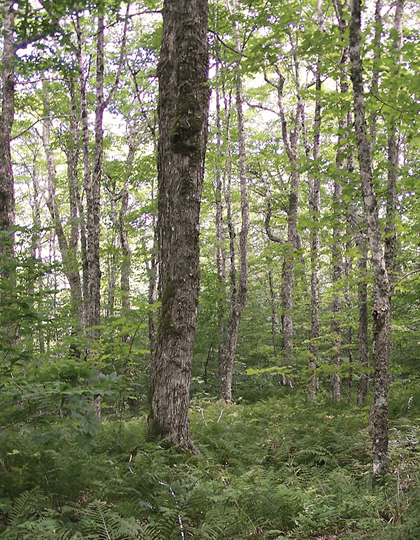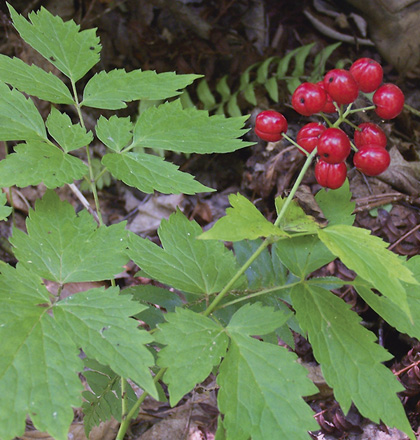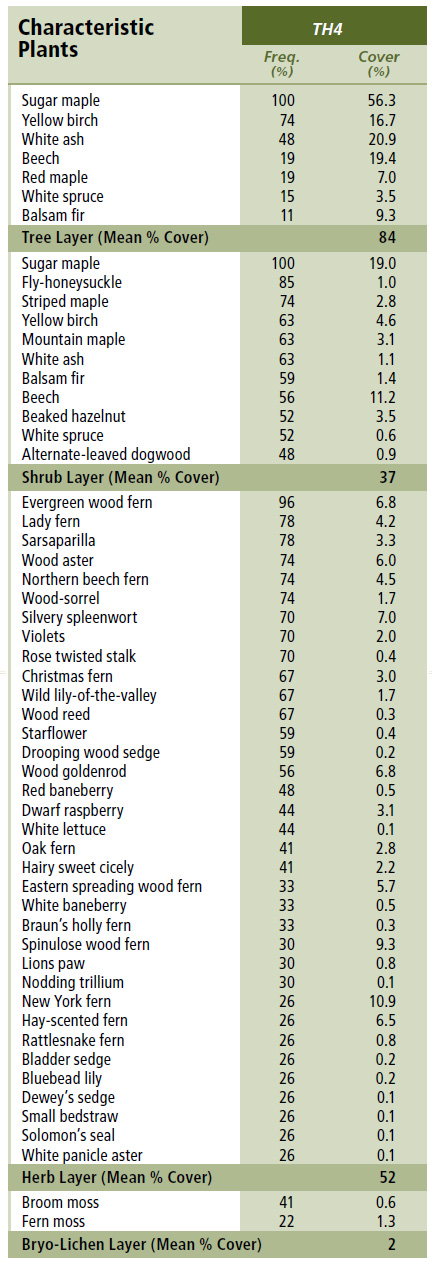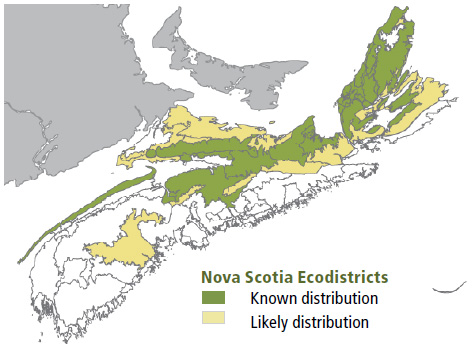
Forest Vegetation types - TH4
TH4 — Sugar maple – White ash / Silvery spleenwort – Baneberry
Acer saccharum – Fraxinus americana / Deparia acrostichoides – Actaea spp.
 |
| Sandy Gunn Lake, Pictou County |
Concept: This late successional Vegetation Type (VT) has an overstory dominated by sugar maple, white ash and yellow birch. TH4 primarily occurs as a small patch VT on rich seepage sites embedded within larger tracts of TH1 and TH2 matrix forest. It is similar to TH3 (Sugar maple – White ash / Christmas fern), but is even more fertile, supporting numerous rich site indicator species. TH4 is the richest upland hardwood VT in Nova Scotia and, excluding floodplain forests, has the most diverse suite of understory plants. Due to the long-lived and shade-tolerant nature of dominant overstory trees, this VT will develop old forest characteristics which are maintained by gap disturbance. Sugar maple – White ash / Silvery spleenwort – Baneberry is one of several Acadian hardwood VTs found on zonal sites throughout Nova Scotia.
Vegetation: Sugar maple is the dominant overstory tree with lesser amounts of white ash and yellow birch. Scattered ironwood (when present) is typically found in the lower canopy or high shrub layer. The shrub layer is dominated by regenerating hardwood (mainly sugar maple) along with fly-honeysuckle, striped maple, mountain maple and beaked hazelnut. Alternate-leaved dogwood, if present, is diagnostic of this VT. Herb coverage is diverse and includes a suite of rich site indicators such as lady fern, sweet cicely, silvery spleenwort, wood goldenrod, Christmas fern, northern beech fern, red and white baneberry and oak fern. Spring ephemerals may include spring-beauty, Dutchman's-breeches and dog tooth violet. The bryophyte layer is poorly developed, with moss cover generally restricted to tree trunks, stones and downed woody material.
Environmental Setting: TH4 is found on fresh-moist to moist, nutrient rich soils associated with seepage sites. These sites often occur where slope angle decreases as in toe slope positions and mid-slope benches. This VT is typically associated with (and found embedded within) larger tracts of TH1 and TH2 matrix forest. TH4 is mainly found in the Cobequid Hills, North Mountain and Cape Breton Hills ecodistricts. It is very rare on Prince Edward Island but abundant and widespread in southern New Brunswick.
Successional Dynamics: TH4 is a late successional, uneven-aged climatic climax VT dominated by shade-tolerant hardwood. Excluding harvesting, stand-level disturbance events are rare with gaps or small patches usually created by individual tree mortality, wind, or ice damage. Although TH4 sites generally maintain themselves through gap replacement, this VT can develop from other early and mid-successional VTs including IH3 (Large-tooth aspen / Christmas fern – New York fern) and IH5 (Trembling aspen – White ash / Beaked hazelnut / Christmas fern).
Ecological Features:This hardwood seepage forest typically occurs in small patches (less than 1 hectare up to 10 hectares), infrequently scattered as inclusions within broader hardwood matrix forest. Longevity of the overstory tree species increases the potential for old growth forest development. Vernal pools and moist surface depressions common in this seepage forest provide habitat for red-backed salamanders, yellow-spotted salamanders and wood frogs, while seeds of ash and maple trees may be eaten by evening grosbeaks. Plants that favour moist rich sites are common, including several rare species (e.g. lance-leaved and little grapeferns, foamflower and anise-root). This forest has the highest fern diversity of all VTs in the TH group, with 13 species present at least 20% of the time. These forests also host a variety of spring ephemeral plants like spring beauty, dog tooth violet and Dutchman's breeches that take advantage of early spring sunlight before tree leaf out.
 |
| Red baneberry |
Distinguishing Features: This is the richest upland hardwood forest and occurs on moist, middle to lower slope positions. The abundance of white ash, ironwood, and alternate-leaved dogwood can be used as a diagnostic feature of this forest. The presence of silvery spleenwort, hairy sweet cicely and ostrich fern are diagnostic of this rich, seepage forest.
| Slope Position: | Lower3 Middle3 Upper2 Crest1 Level1 |
Surface Stoniness: |
(Non - Slightly)5 (Moderately)4 (Very - Excessively)1 |
Bedrock Outcrop: |
(Non-rocky)9 (Slightly - Moderately)1 |
Elevation Range: |
94 - 286m |
Slope Gradient: |
Gentle5 Moderate3 Level1 Steep1 |
Aspect: |
North1 East2 South3 West3 None1 |
Exposure: |
Moderate3 Mod. exposed3 Exposed2 Mod. Sheltered1 Sheltered1 |
Microtopography: |
Moderately4 Slightly4 Strongly1 Other1 |
Drainage: |
Well4 Moderately well4 Imperfect2 |
Soil Type: |
ST84 ST93 ST2-L1 ST61 Other1 |
Parent Material: |
Glacial till7 Colluvium2 Till/Bedrock1 |
Rooting Depth (cm): |
(<30)2 (30-45)4 (>45)3 nd1 |
Duff Thickness (cm): |
(0-5)4 (6-10)3 (11-20)1 (21-40)1 nd1 |

